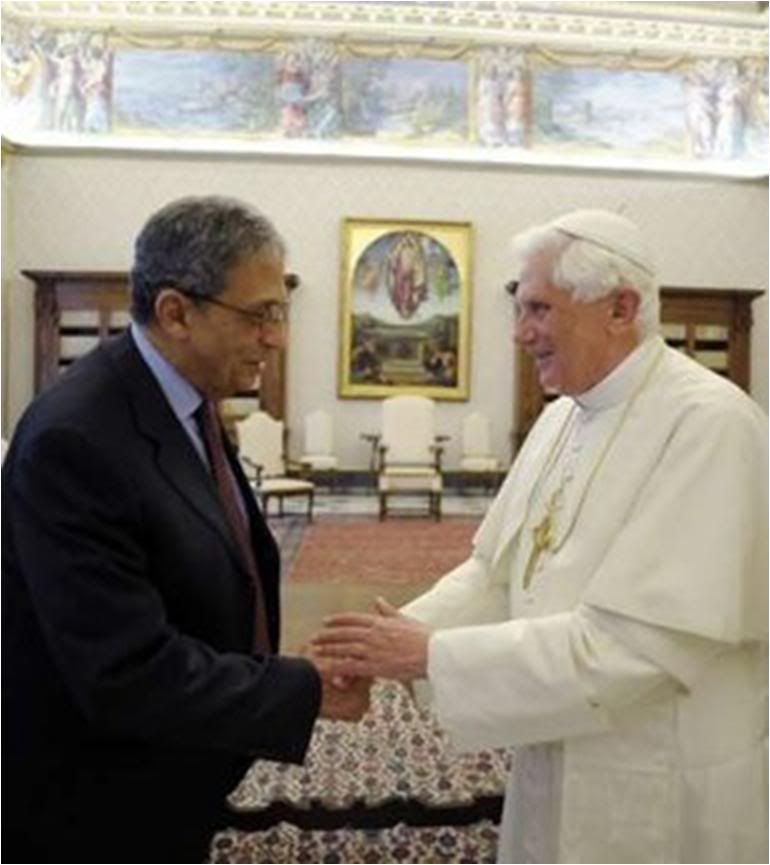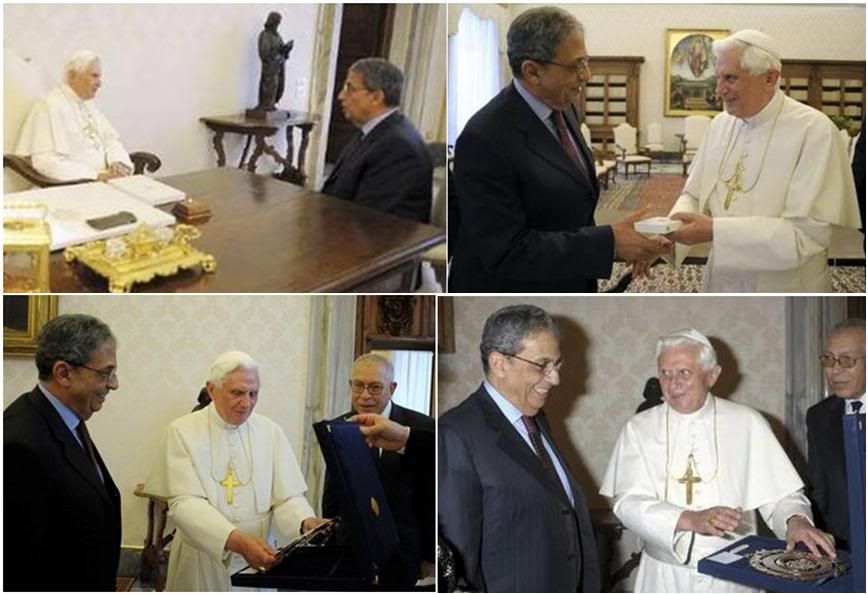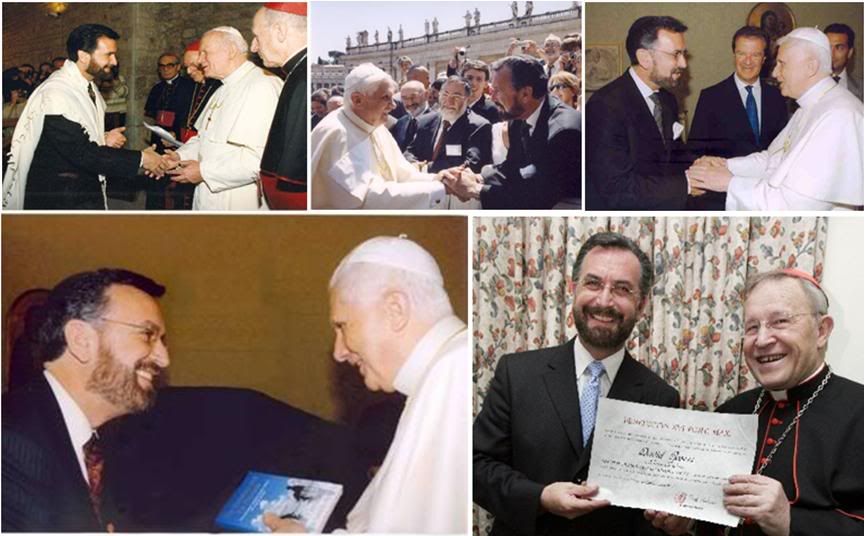
 Vatican and Arab League agree
Vatican and Arab League agree
to work together toward world peace


VATICAN CITY, April 24 (AP) - The Vatican and the Arab League have agreed to work together to promote peace and justice in the world, the Vatican said Friday, after a meeting between Pope Benedict XVI and the league's secretary-general.
In a separate meeting, Amr Moussa and the Vatican's foreign minister, Archbishop Dominique Mamberti, signed a memorandum of understanding between both sides, a Vatican statement said.
During the cordial meetings, emphasis was placed on the importance of the agreement, which is intended to foster increased cooperation between the parties with a view to promoting peace and justice in the world. Particular importance was given to the role of intercultural and inter-religious dialogue, the Vatican statement said.

The meetings allowed for an exchange of view on the international situation, especially in the Middle East, and on the need to find a just solution to the Israeli-Palestinian conflict and to the other conflicts which afflict the region, the Holy See said.
The Pope travels to the Middle East next month on a Holy Land pilgrimage. Benedict will visit Jordan, Israel and the Palestinian territories.
Benedict's envoy to Egypt, Archbishop Michael Fitzgerald, told Vatican Radio that besides appreciating the Pope's interest for peace and development in the region, the Arab League also takes into account the situation of Christians in Arab countries.
The Vatican has long shown concern for the Christian minorities in the Middle East.
As part of its interest in looking after its flock in the Holy Land, the Vatican and Israel have held periodic talks over several years to resolve long-standing differences over tax and property matters.
The Holy See and Israel said in a joint communique that a session between both sides in Jerusalem on Thursday yielded meaningful progress toward resolving these differences.
The latest meeting of the Bilateral Permanent Working Commission was characterized by great cordiality and a spirit of cooperation, the statement said.
Without describing the progress made, it said both sides want to reach agreement as soon as possible and will meet again next week at Israel's Foreign Ministry.
Israel and the Vatican established diplomatic ties in the early 1990s, but they still must resolve the status of expropriated church property and tax exemptions.
On wider issues, tensions between both sides have sometimes marked their relations. Earlier this year, Benedict's lifting of the excommunication of a bishop who had denied the Holocaust caused anger among Jews as well as Catholics and others worldwide.
Last month, the Pope made an unusual public acknowledgment of Vatican mistakes of turmoil caused by his reaching out to the renegade, ultraconservative prelate.
The Vatican has said that Benedict did not know that the British-born bishop was a Holocaust denier.
Now, from the Jewish side -
Catholics and Jews
for peace in the Middle East:
Pope's visit will see progress
in the historical process of reconciliation
by David Rosen
Grand Rabbi
President, International Jewish Committee for Inter-Religious Consultations
International Director, Inter-Religious Affairs, American Jewish Committee
Translated from
the 4/24/09 issue of

Last March 12, Benedict XVU received the delegates of the Grand Rabbinate of Israel and the Holy See Commission for Religious Relations with Judaism.
The Pope expressed the hope that his visit to Israel would reinforce relations between Catholics and Jews, as well as promote peace in the region.
All persons of good will pray fervently that this last hope may be realized. Nonetheless, there is no doubt that his visit will in fact intensify the historical process of reconciliation between Catholics and Jews, and not only because the Pope will thereby show good will to the almost six million Jews who live today in the Holy Land.
Benedict XVI will follow in the footsteps of his great predecessor, literally and figuratively.
John Paul II, hero of the reconciliation of Catholics and Jews in our time, fully understood that the visit of a Pope to Israel carried a special significance for the reconciliation between Jews and Christians.
Already in the Apostolic Letter
Redemptionis anno published on April 20, 198,, John Paul II spoke of "the land we call holy', referring to the significance that Jerusalem has for Christians, Muslims and Jews.
About the last, he wrote: "For the Jews, the city is the object of a vibrant love and perennial claim, rich with numerous imprints and memories, since the time of David who chose it to be his capital and Solomon who built the Temple there. Since then, they have looked on it every day, one might say, as the symbol of their nation."
These penetrating sentences reflect John Paul II's understanding not only of the historical significance, but also the religious and existential, of the land of Israel for the Jewish people.
Jews 'look to' Jerusalem, and three times a day. they bow in prayer towards Israel if they are in the diaspora; towards Jerusalem, if they are in Israel. And if they are in Jerusalem, they face Temple Mount, the place where the Almighty chose "to establish his name" (Deut 12, 5-11).
The religious link between the Holy and and the Holy City is an integral and incancellable part of the Jewish calendar and liturgical celebrations. It reflects simply the Biblical mandate to "be a kingdom of priests a holy nation" (Ex 15,6), which demands that persons live ideally as a paradigm "like the day of heaven over the earth, in the land that the Lord vowed to give your fathers" (Deut 11,21; cfr Ex 6, 4-8).
Indeed, the whole Biblical narrative is indissolubly linked to the land. Exile from it is seen not only as a humiliation, but also as 'a profanation of the divine name'.
Consequently, return to this land is considered not only as an essential element of the universal mission of Israel, but also the sanctification of the divine name itself(Ez 36,23).
This centrality of the city and of the land in the Jewish consciousness has brought a remarkable self-identification with it, which is particularly reflected in the Prophets and specially in the book of Isaiah, in which the population is often described as the 'daughter of Zion', and even as Zion itself. The passage in the morning liturgy of Sabbath, "Have mercy on Zion because it is the dwelling of our life" reflects this identification.
The observations of John Paul II in
Redemptionis anno reflect this idea, that for the Jews Jerusalem and tehhe Holy Land are not only the historical focus but also the 'sign' of their identity.
Unfortunately, for the greater part of the tragic history of relations between Catholics and Jews, this religious and existential link between the people of Israel and the promised Land has been seen by Christianity as something obsolete, that had become deprived of legitimacy and validity.
Indeed, the very idea of the return of the Jewish people to that land and the renewal of their sovereignty was often considered anathema.
The historic document of the Second Vatican Council,
Nostra aetate, rejected the idea that the Jewish people have been spurned by God and affirmed that the divine alliance with the people of Israel is eternal.
Nonetheless, at the same time, the Holy See has not recognized the return of a Jewish life that is independent of the restored State of Israel, and the Jewish people (and I believe, the Catholic world, too) have perceived that the Church still had a 'problem' with Jewish sovereignty in the Holy Land and in Jerusalem.
It is interesting what is narrated by Archbishop Loris Capovilla, who was John XXIII's secretary. That Pope, faced with the new relationship of the Church with the Jewish people - established through
Nostra aetate - wished to officially recognize the state of Israel. But he did not live long enough to see the promulgation of Nostra aetate itself and events of a principally political character caused a delay of another 28 years until the normalization of relations.
The document published in 1985 by the Commission of the Holy See for Religious Relations with Judaism, entitled "Note on the correct way to present the Jews and Judaism in the preaching and catechism of the Roman Catholic Church", based on
Nostra aetate, defined the persistence of Israel as "a historical fact and a sign to interpret in the light of God's plan".
The document states that " the story of Israel did not end in 70 A.D., and continued, particularly in the numerous communities of teh diaspora which allowed Israel to bring the whole world testimony, often heroic, of its faithfulness to the one God and "to exalt him in the presence of all the living" (Tobit 13,4), maintaining at the same time, a memory of the land of their predecessors at the center of their own hopes" (Passover Seder).
The document adds that "Christians are invited to understand this religious attachment, which has its roots in Biblical tradition".
Consequently, the promise of teh land is an essential aspect of that alliance which is always valid, so that it is recognized that the relationship between the Jewish people and the land of Israel has its origin "in Biblical tradition".
Therefore it is presented as an aspect of teh Christian faith to be exposed as such in Catholic teaching adn preaching. As Eugene Fisher stated, who was then responsible for relations between Catholics and Jews in teh US Conference of Catholic Bishops, "the theological importance, and indeed, doctrinal, of this statement must not be underestimated."
Ant Another eight years passed before such recognition was concretized. Above all, thanks to the guidance and commitment of John Paul II at the end of 1993, the signature of the Fundamental Agreement favored full relations between the Holy See and the State of Israel.
This, in turn, made possible in the year 2000 the historic pilgrimage of John Paul II to the Holy Land, which had an enormous impact.
One of the characteristic aspects of John Paul II's Pontificate was the ability to transmit these messages on a vast scale, which up to that moment had been present only in the teachings and documents of teh Magisterium.
He did it above all by understanding and utilizing teh power of teh visual message. That was the case with his visit to the Synagogue in Rome and even more so, with his visit in Israel.
[But global TV has meant since the 1970s that every event is seen in images and no longer just read about! The images would have been there whoever was Pope.]
The greater part of Israeli Jews, in part5icular, those who are most observant and traditionalist, have never met a modern Christian. These persons, when they travel abroad, meet non-Jews only as such, rarely as Christians.
Therefore they carry the prevalent image that Jews have had of Christianity from tragic and negative past. The papal visit to Israel has opened their eyes to this new reality. Not only is the Church no longer considered hostile to the Jewish people, but its chief is seen as a sincere friend!
In an ample sector of the Israeli population, there was a profound impact to see the Pope at Yad Vashem, the memorial to the Shoah, in tears of solidarity with the sorrow of the Jews; too learn in what way he hiumself contributed to save Jews in that terrible time, and later as a priest, how he returned Jewish children who had been protected in Christian homes to their own Jewish families; and t4o see the Pope leave at the Western Wall, in respectful revrence for Jewish tradition, the text of the prayer he had composed for the Day of penitence celebrated on March 17 at St. Peter's Basilica, in which he asked divine pardon for the sins committed against the jews in the course of centuries.
Not the least, even if his trip had been described as a pilgrimage, the visit was also a state visit, with its appropriate ceremonials, affirming the respect of the Holy See for the contemporary expression of of Jewish independence asnd integrity which are linked indissolubly to the Jewish identity in teh whole world.
The visit of John Paul II also achieved another important result, when during the meeting with the Chief Rabbi and the Council of the Grand Rabbinate of Israel, the Pope proposed the institution of a special Bilateral Commission for dialog between the Holy See and teh Grand Rabbinate, which was created in due time and carries out annual meetings, alternatively in Rome and in Jerusalem.
In the past eight years, the work of the Commission presided by Chief Rabbi Shera Yashuv Cohen and Cardinal Jorge Maria Mejia has led many persons of the Israeli rabbinical community to an authentic appreciation of of the leadership and teaching of the Catholics and of friendship with them.
This Commission involves persons which makes it an echo chamber which influences the perceptions and attitudes of manny others. The images which gradually makle their way to Israeli society, thanks to these meetings and collaboration, are very impportant too promote the educational process aimed at greater respect and greater reciprocal understanding
Thanks to this Commission, which was received by Benedict XVI last March 12, the special links of the Catholic faith with the Jewish people were reaffirmed, and the Holy See reiterated its profound commitment to continue promoting relations between Catholics and Jews.
In visiting Israel and expressing the respect of the Holy See for the Jewish state, reinforcing the impact of teh pioneering visit of his predecessor, Benedidt XVI will dooubtless make furthe rprogress in the historic profess of reconciliation between Jews and Christians.
Let us pray that his visit may a;sp promote the other objective, mentioned by the Pope, of promoting peace adn reconciliation among the populations and faiths of the Holy Land, and in all the Middle East.
David Rosen is probably one of the most active interfaith advocates in the world. Photos show him with John Paul II in Assisi in 1993, with Benedict XVI on three occasions in 2005 alone, during which he was made a Papal Knight of the Order of St. Gregory the Great, conferred on him by Cardinal Walter Kasper.
